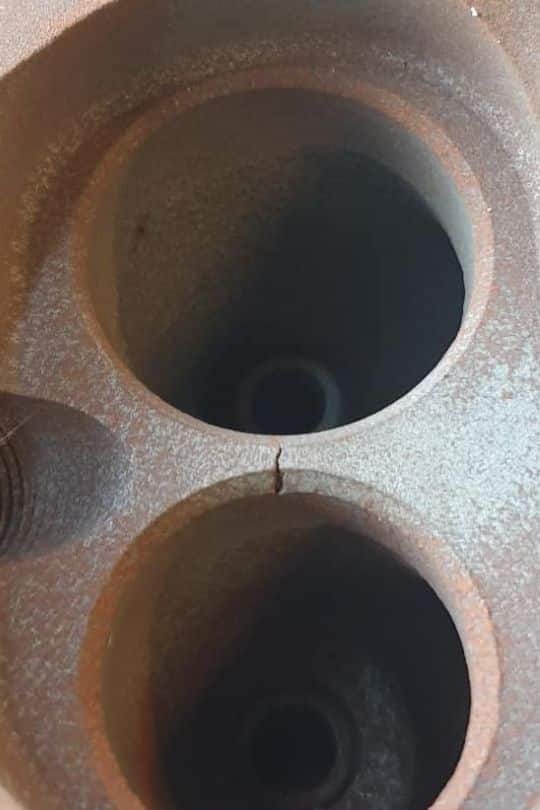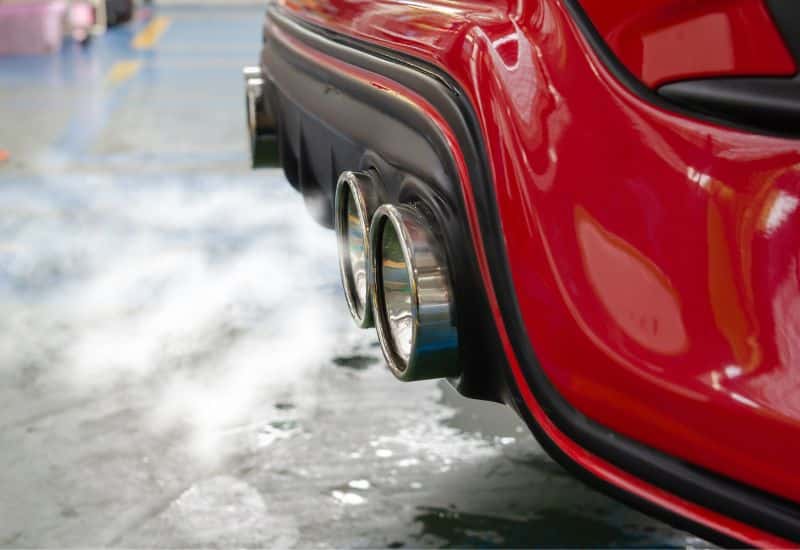
White smoke coming out from your car’s exhaust for more than a few seconds after starting the car is usually a sign that the engine is burning coolant in some way or another.
Most of the time, you’d be right to jump to the conclusion that it’s a head gasket problem.
And while a faulty head gasket is a common culprit, it’s not the only one to blame. In fact, there are many other reasons why your vehicle’s exhaust emits thick white smoke, each potentially more problematic than the last.
To help you figure out what’s really gone wrong and what can be done to fix it, we’re going to have to wave away the fumes of confusion to understand all your options clearly.
What Does White Smoke From Exhaust Mean?
White smoke typically means that coolant is leaking into the engine and is being burned in the combustion chamber. This usually also causes the engine to run hot and/or overheat easily.
Is White Smoke from Your Exhaust a Cause for Concern?
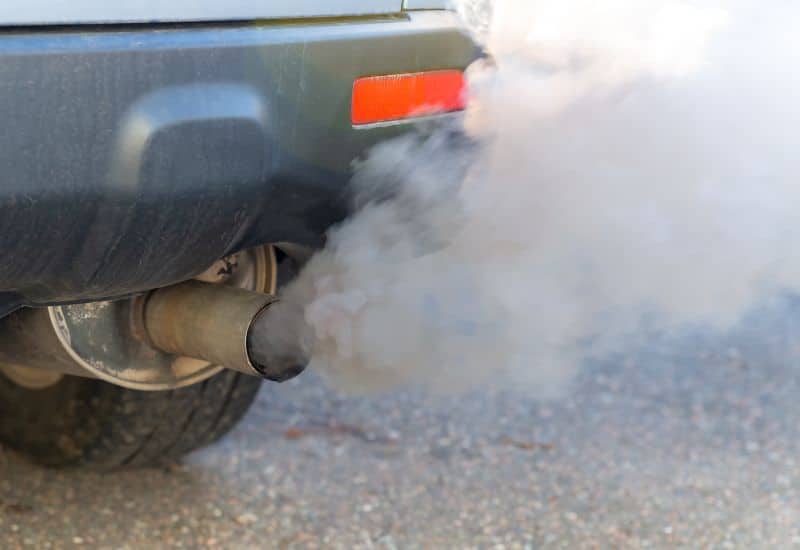
Yes, white smoke from the exhaust can be a sign of a problem with your vehicle’s engine or fuel system. Most of the time it’s either a failing or blown head gasket or a cracked cylinder, which is a major problem, and a potentially expensive repair. Compounding this problem is that most cars with white smoke coming out of the exhaust typically overheat easily.
This can worsen the existing problems with the cylinder head or block. It can also blister spark plugs, damage the engine cooling system, and cause serious, expensive damage to your car.
5 Reasons Why You Have White Smoke Coming Out of the Exhaust
White smoke coming out of the exhaust usually means you have a bad head gasket or a cracked cylinder head that’s allowing coolant to be burned in the combustion chamber. Though this isn’t the only possible problem afoot.
The most causes that may result in white smoke to come out of your car’s exhaust system include the following:
1. A Bad Head Gasket
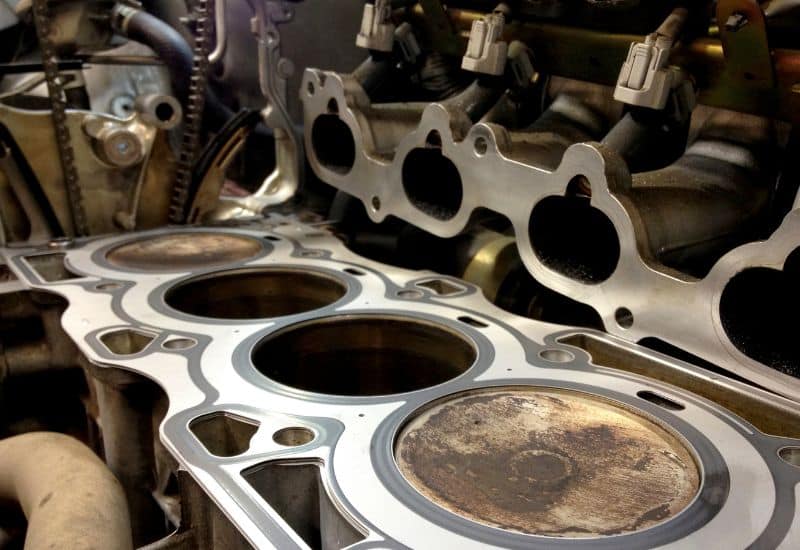
A bad head gasket is the most likely reason you have white smoke from the exhaust. The gasket plays a crucial role in sealing the combustion chamber to provide compression for the internal combustion process while also preventing gases from getting into the coolant system.
A head gasket failure is usually due to an engine running hot and/or overheating. This can cause the gasket material to degrade, allowing gasses to get into the coolant system and coolant to infiltrate the combustion chamber in small volumes. This means that a coolant system problem can cause a head gasket problem, which can then foul the coolant system more while also causing white smoke to come out of the exhaust.
A minor failure in a head gasket can also impact engine performance as it affects the necessary compression needed to maintain vigorous internal combustion. This causes the engine to feel like it’s down on power. Once a head gasket gets a minor leak, it can worsen quickly, leading to a full-blown gasket. It could even cause the engine to overheat so badly that it cracks the head or causes more severe engine damage!
How to Diagnose a Bad Head Gasket
Diagnosing a bad head gasket starts with recognizing the overt signs of coolant in the combustion chamber. This includes white smoke coming out of the exhaust, as well as:
Sometimes a bad head gasket will throw a code P0217, which is a general code for engine overheating. In some models, this is enough to cause the check engine light to come on as well.
How to Fix a Bad Head Gasket
Depending on the severity of the leak in the head gasket, you might be able to repair it with a sealer additive, without having to replace the faulty gasket fully.
Fixing a Minor Head Gasket Leak with Sealer
You can easily find head gasket sealers online or in auto parts stores. Though I usually found BlueDevil 38386 and GREEN DEMON head gasket sealer more effective that others.
Now, how to use these sealant..
It’s understandable if you get a little white smoke coming out of the exhaust for a few minutes as their might be residual traces of coolant in the system. Though if it’s still pouring white smoke and the engine is still running hot, then your head gasket likely needs to be replaced.
Even if the head gasket sealer does the job, you shouldn’t expect it to be a permanent fix. At best you’re looking at 3 to 6 months before it fails. In my experience, the hot months of summer shorten this window of time.
When the head gasket sealer does finally break down, you might get lucky with a second application. Though you should expect that it won’t work as well on the second go, you’ll likely need to replace the head gasket at that time.
Replacing a Head Gasket with a Major Leak
Replacing a head gasket isn’t the sort of thing that the average home mechanic can do. So, the wise move is to have it professionally repaired. Especially since your coolant system and radiator fluid are likely also fouled in some way.
The cost to have a professional mechanic replace your head gasket ranges from $1,500 to $2,500, with the cost for parts being about half of the final bill.
2. A Cracked Cylinder Head
If severe overheating occurs or a blown head gasket goes unchecked, it can lead to white smoke emissions from the exhaust system and potentially result in a cracked cylinder head. This is a critical component on the top of the engine that seals the cylinders to create the necessary compression for robust internal combustion.
It also serves as the housing for a variety of critical components, including the spark plugs the intake & exhaust valves, springs & lifters. The cylinder head also has channels built into it to help evenly distribute the oil and coolant throughout the engine.
Severe overheating causes the cylinder head to expand. It can then crack under severe thermal stress and/or when it is allowed to cool again rapidly. Once it cracks coolant and oil can be introduced to the combustion chamber in random amounts, which burns to create white smoke in the exhaust.
How to Diagnose a Cracked Head
A lot of the symptoms of a cracked head are similar to but more extreme than a bad head gasket. This includes things like:
While there isn’t a specific code for a cracked head, you might get a code P0171 or P0174. These codes indicate that the engine is running too rich or too lean.
How to Fix a Cracked Cylinder Head
There are three potential avenues for fixing a cracked head that’s causing white smoke to come out of the exhaust. The severity of the crack and how much damage has been done to the related engine components will determine the most viable repair option.
I. Fixing a Cracked Head with a Sealer
If the crack in the cylinder head is very minor, and you caught it at the first sign of white smoke coming out of the exhaust, you might be able to pull off a short-term fix by adding some of the same gasket sealers. This is the same stuff we discussed earlier regarding a bad head gasket.
In my experience this will only work if the crack is very minor, it just happened and it will only last for a few weeks at best. Though it might buy you enough time to save up for a more serious repair bill or get you through the rest of your work week.
How to Tell If the Sealer Worked?
The best metric to tell if this works is to let the car idle for 45 minutes. If it can’t make it the full 45 without overheating, and/or you still have white smoking coming out of the exhaust, then the crack in the head was too much for the sealer.
II. Fixing a Cracked Head by Pinning or Welding
Some minor cracked cylinder heads can be repaired by pinning or welding. The severity of the crack and the type of metal the cylinder head is made out of will determine the method your mechanic recommends. However, this is not the sort of thing the average DIY home mechanic can do.
The cost to have a mechanic weld or pin a cylinder head will vary from $500 to $1,200 for parts and labor.
III. Replacing the Cracked Cylinder Head
Replacing a cracked cylinder head is the most effective and arguably the most common repair. This is something that should only be done by a certified mechanic, and you can expect there to be other faults that need to be addressed with the oil and coolant systems.
The cost just to have a mechanic replace a cracked cylinder head varies from $2,100 to as much as $3,800.
You might be able to shave $200 to $300 off the final repair bill if you source a secondhand replacement cylinder head from a junkyard or a scrap parts dealer.
3. A Damaged Coolant Reservoir or Coolant System Fault
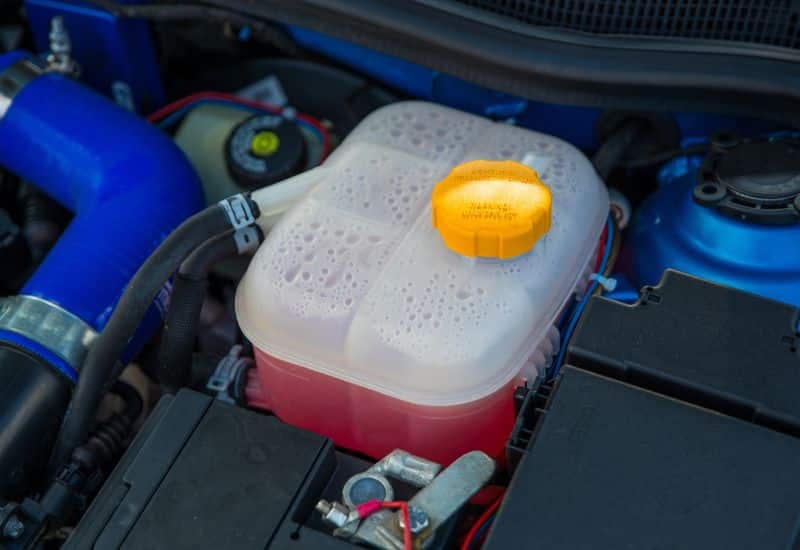
A damaged coolant reservoir or a fault in the engine’s cooling system can sometimes create white smoke without there being anything wrong with the cylinder head or the head gasket. Though this is admittedly rare, yet still worth checking into when diagnosing the problem.
How to Diagnose a Coolant Reservoir Leak
If there’s a fault in the coolant reservoir or some other part of the engine cooling system, but the head gasket and cylinder head are still in relatively good condition, you’ll notice the white smoke in the exhaust only once the engine is fully warmed up.
At this point, you need to look meticulously through the engine bay for signs of a leak, all while making sure someone else is watching the temperature gauge on the dash. You will feel like you’re chasing gremlins, but you might get lucky if you spot a leak.
Coolant that is finding its way into the combustion chamber without a head gasket failure will also give the white smoke a sweet-smelling odor. It might even throw a code P0128, the code for the coolant thermostat below the thermostat regulating temperature.
Many times when you’re trying to find the fault in the coolant reservoir tank or a leak in the coolant system lines, it ends up leading to you finding a minuscule crack in the engine block.
4. A Cracked Engine Block
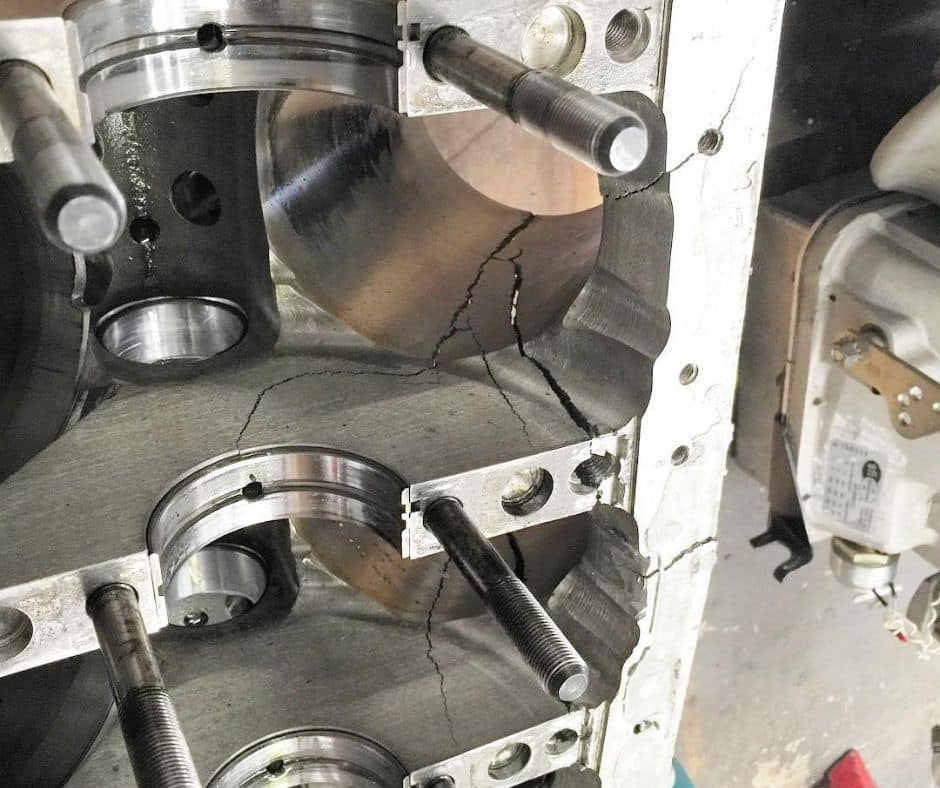
If the head gasket and cylinder head are good, but you still have white smoke coming out of the exhaust, the next most likely cause is a cracked engine block. This is a worst-case scenario and the most expensive repair bill of all the possible options.
The engine block in most modern-day cars is made from either aluminum alloy or robust cast iron, which can handle the extreme heat of internal combustion. Still, severe overheating events can affect the engine block causing it to crack.
Cracked blocks are more common in the wintertime in northern-tier states when the car’s water pump fails. The engine seems to run cold due to the outside weather. Suddenly the heater starts blowing cold in the cab, and the engine block temperature gauge on the dash starts pegging.
Diagnosing a Cracked Engine Block
A cracked engine block with white smoke coming from the exhaust will usually have discolored puddles of coolant and puddles of fluid under your car. You might even be able to trace the drips back to a visible crack in the engine block. Though sometimes, the crack occurs near a bolt hole or in a cylinder wall where it isn’t immediately visible.
A lot of times, when you have a cracked block, you’ll also have coolant fouling the engine oil. This will give you milky oil in conjunction with white smoke in the exhaust with a blue tinge. In the deep winter, you might also have frozen coolant in the radiator.
How to Fix a Cracked Engine Block
Setting aside dubious bush fixes, when you have a cracked engine block the options come down to a possible repair or having to replace the engine completely. Only a certified mechanic with experience in engine block repair can give you an accurate assessment of which route is best.
The cost to have a certified mechanic repair a cracked head will range between $500 to $1,500. The location of the crack and its severity will greatly influence the final bill.
The cost to replace a severely cracked engine block can range from $3,000 to $5,000. You might be able to save a little bit if you have a slightly older car and you can find a replacement block in good condition through a scrap auto parts dealer. Though this is still only going to be a few hundred dollars.
5. A Bad Fuel Injector
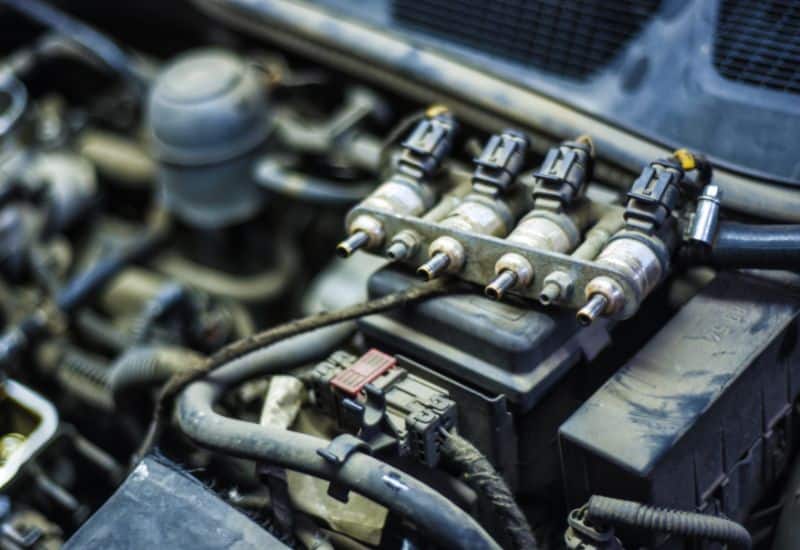
A fuel injector that is stuck open can also cause white smoke to be emitted from the exhaust system. When this happens there is simply too much fuel in the engine, and it’s passing down into the exhaust system. This will manifest as white smoke with a gray tint to it.
A stuck-open fuel injector that causes white smoke in the exhaust might also be through a code that starts with P02. Then it will be followed by another number, indicating the cylinder that’s having a problem. For example code, P0202 would mean there’s a fault in cylinder number 2.
Frequently Asked Questions
Why is my exhaust smoking white but not overheating?
White smoke from the exhaust without the engine running hot or overheating could be a fuel injector stuck open. This will create grayish-white smoke and is usually accompanied by hard idling, frequent stalling, and dangerous misfires.
It could also be that you are at the start of a minor leak in the head gasket, which is allowing a miniscule amount of coolant into one of the cylinders. If this is the case, you’ll likely see the heat rise on the dash instrument cluster when you let the car idle for 30 to 45 minutes without stepping on the accelerator.
Is it safe to drive a car with white smoke?
If the white smoke coming out of your exhaust is from a stuck open fuel injector, a coolant system leak, or even a minor leak in the head gasket, you might be able to limp home or drive it for a few days. Though it’s wised to get the problem fixed as soon as possible to prevent more severe engine damage.
If your car is running very hot, overheating, or misfiring with white smoke coming out of the exhaust, then you likely have a serious problem, and it’s not safe to keep driving. These are usually signs of a bad head gasket, a cracked cylinder head, or a cracked engine block. The more you drive a car with these problems, the worse the damage will be, the higher the repair cost will be, and the more likely you are to be catastrophically stranded.
Does white smoke always mean a blown head gasket?
White smoke doesn’t always mean a blown head gasket, but it is the most likely reason why you have white smoke coming out of the exhaust. It could also be a cracked block or cylinder head, which is far worse than a blown head gasket.
If you’re lucky, and the white smoke is tinged with gray, it might be that a fuel injector is stuck open. This won’t cause severe overheating, but the rough idle and potential misfires can still be dangerous.
Does white smoke mean low coolant?
White smoke often means that the engine is burning coolant for some reason. This will cause the coolant level to drop gradually. It also means that the engine will start running increasingly hotter. This alone can worsen a small leak in a head gasket, turning it into a major problem.
If you do notice low coolant and you have white smoke coming out of the exhaust, you should top up your radiator fluid. Though this isn’t a fix by any means. You’re just giving your car’s engine cooling system the best possible chance to do its job while you figure out what’s causing the problem.
Does white smoke mean low oil?
White smoke is often associated with coolant burning, which is often a telltale sign of a problem with the head or head gasket. Sometimes a cracked head or head gasket can allow oil to also get into the system.
You can then end up with low oil as it migrates into the coolant or is burned in the engine. If you have oil getting into the combustion chamber, it often adds a blue tinge to the exhaust and will have the foul odor of burning oil.
Why is my car blowing white smoke when I accelerate?
Anytime coolant is getting into the combustion chamber; it will produce white smoke, which will increase in volume when you accelerate. If this occurs and the engine has been running hot or overheating, it’s likely a blown head gasket or a crack in the cylinder head.
If your car isn’t overheating, but it’s blowing white smoke with a gray tinge to it, and you experience misfires, it might be that a fuel injector is stuck open. This will also be followed by poor MPG, a very rough idle, and frequent stalling.
Conclusion
White smoke coming out of the exhaust is usually caused by a blown head gasket or a cracked head. These serious issues must be dealt with as soon as possible, especially if the car is running very hot or in danger of overheating.
When coolant is allowed to get into the combustion chamber, you get white smoke and a gradually decreasing volume of coolant. This further causes the car to run increasingly hot, increasing the risk of further damaging the car. So, it’s wise to go home or to the mechanic to diagnose the problem properly.
Sometimes with a minor head gasket leak or a small crack in the cylinder head, you can get by for 3 to 6 months by adding some sealant to the radiator. Then a short drive of 15 to 20 minutes to let it circulate through the system and several hours of cooling will “Patch” the problem.
Even if the sealant works for a while, it will inevitably give up, and you’ll see white smoke coming out of the exhaust again. At this point, you’ll need to either have the head gasket or the cylinder head replaced.

Written By
Jason Farrell
Jason Farrell is a certified master technician, the editor of Mechanic’s Diary in Pittsburgh, Pennsylvania. He is ASE (Automotive Service Excellence) certified and earned a Bachelor’s Degree in Automotive Technology from Pittsburg State University. With nearly 18 prior years of experience in the automotive field, he has extensive knowledge about Domestic, European, and other foreign makes and models of cars and light trucks. Jason’s experience working as a technician and service manager at dealerships, gave him the experience and know-how of most aspects of inspection, diagnosis, and repair from engine and drivability to electrical, HVAC, brakes, steering and suspension and everything in between.

